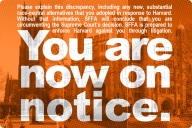You have /5 articles left.
Sign up for a free account or log in.

Students in T-shirts that say "fear nothing" walk to take China's college exam.
AFP / Getty Images
Two years ago, the University of San Francisco announced a plan to admit some students from China without SAT scores, without TOEFL scores and without any of the standard tools used to evaluate international applicants.
The private Jesuit university didn't lack for Chinese students admitted with those tools, enrolling about 1,000. But officials wondered if they might attract 5 to 10 top students each year from China using a new approach. The university made it possible for Chinese students to apply based on the gaokao, the rigorous multiple-day test used for admission to Chinese universities, plus an in-person interview in English, conducted in China by university faculty members, as part of the university's own English-language proficiency test. (The gaokao includes a foreign language section on which most students take English, so the test score is already an indication of language skill, even before the interview.)
As universities in Western nations around the world seek talent (and tuition-paying students) from China, many are looking for an edge, and a few have gone to the gaokao. The University of New South Wales, in Australia, started such an effort in 2013. But San Francisco was the first American university to do so -- and to date it is the only place in the U.S. having success with the strategy.
So far, San Francisco is exceeding its goals for admitting students via gaokao -- and the students admitted this way are doing well academically. In the fall of 2015, 17 new students enrolled this way, and another 16 did so in the fall of 2016. So far, academic performance is strong, with both cohorts having grade-point averages above 3.2.
More striking to the university is that the gaokao-admitted students are splitting about equally between programs in business and in arts and sciences. Typically at the university, Chinese students enroll in the business programs, just as at many universities, business and science/technology programs attract Chinese students in large numbers.
Donald E. Heller, provost at the university, stressed in an interview that the idea behind the program is not to push for a massive increase in the number of Chinese students, but to go after top students who might not otherwise enroll. The students who appear to be enrolling now are those who had top grades in rigorous high school programs and were planning to go to one of the top universities in China, where getting in isn't much easier than getting into an Ivy in the U.S. When they don't get into the very top Chinese universities, they are open to options in the United States, especially if they don't need to wait for the next chance to take the SAT or TOEFL.
The university requires a score among the top 15 percent of those who take the gaokao -- so it is only a fraction of Chinese students for whom this is an option. "These are some of the strongest students in China," Heller said.
He also said that some who do meet the test threshold are rejected when faculty members interview them and find their English communication skills lacking.
Heller doesn't expect this approach to ever be the university's dominant way to admit Chinese students, but he said he is pleased by the diversity of fields students want to study. Further, he said the option has attracted attention in the Chinese press. "This does give us a bit of a competitive edge," he said.
Stanley D. Nel, vice president for international relations at San Francisco, said that he thinks the university's test -- administered in person and in conjunction with an interview -- is the key to making sure students can succeed once they enroll. The test takes an hour and the interview is a half-hour, so students who do well have the English they need.
For the fall of 2016 class, 220 Chinese students applied via the gaokao, and 51 were interviewed, 46 of whom were offered admission.
Nel also said it was important to adjust policies to reflect the way the gaokao works, which doesn't correspond to the experience of using an SAT score. Typically, the university interviews only those who have achieved "tier 1" status in their scores. But China practices geographic affirmative action with the test. So the university interviews some of the top "tier 2" applicants who are from provinces where it is more difficult to get into the top tier.
The university also benefits from having a large population of Chinese students who enroll in a more traditional way, which reflects a strong reputation in China. Plus the university benefits from its location in a much-loved city and one with a large Chinese-American population. Nel said that gaokao needs to be seen as one part of a strategy -- backed up with steps like the test and interviews.
At least one other American institution -- Suffolk University -- followed San Francisco's announcement by saying it would also accept gaokao scores with an interview in place of standard admissions tests. But thus far, Chinese applicants there have gone the traditional route.








